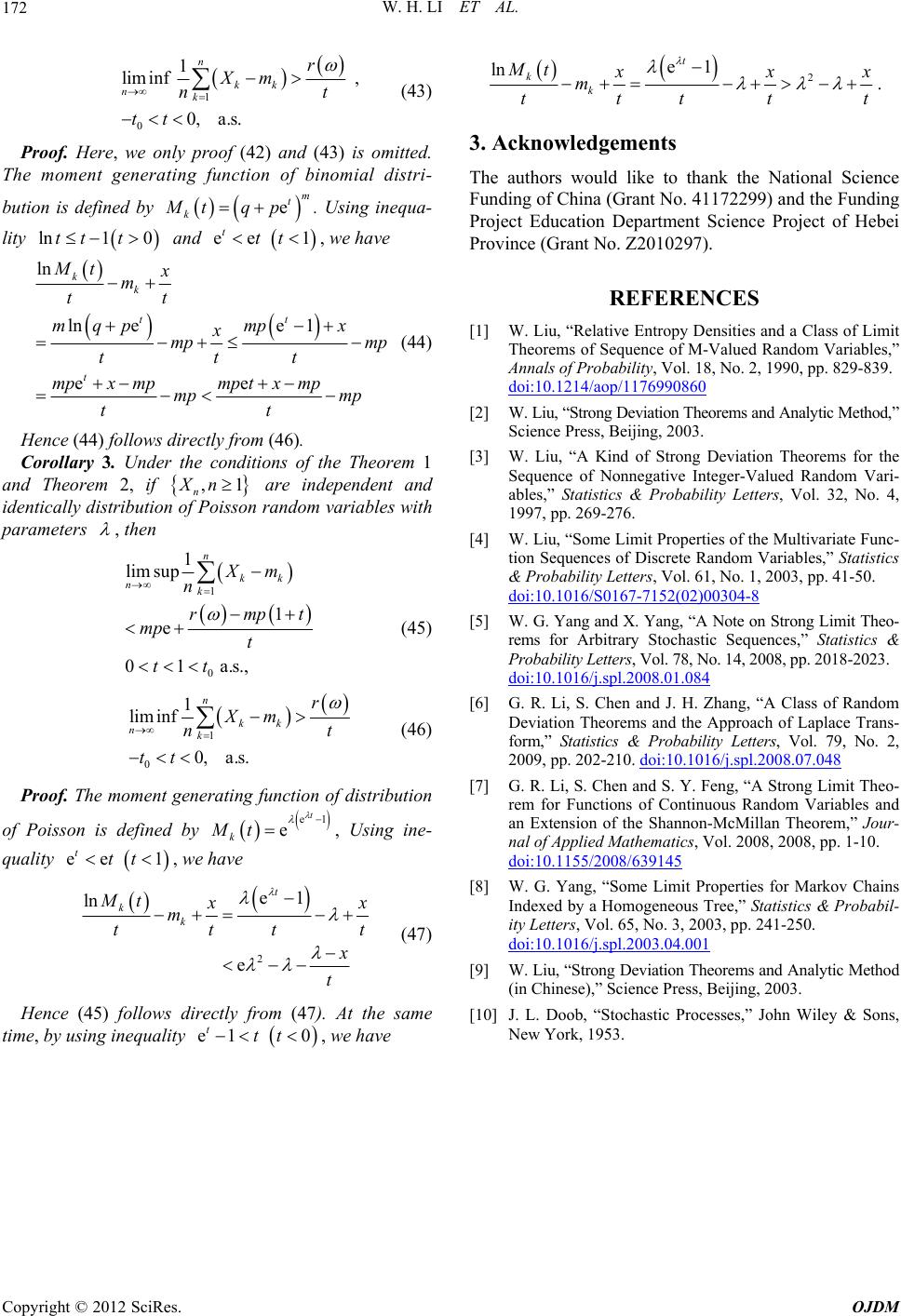
W. H. LI ET AL.
Copyright © 2012 SciRes. OJDM
172
1
0
1
lim inf,
0,a s
n
kk
nk
r
Xm
nt
tt
(43)
Proof. Here, we only proof (42) and (43) is omitted.
The moment generating function of binomial distri-
bution is defined by. Using inequa-
lity and
em
t
k
Mt qp
t
ln1 0tt t
ee 1tt
, we have
ln Mt
lnee 1
k
tt
m
tt
mq
pmp x
x
ee
k
t
x
mp t
mp xmpmptxmp
tt
Hence (44) follows directly from (46).
Corollary 3. Under the conditions of the Theorem
and Theorem 2, if are independen
identically distribution andom variables with
parameters
mp
tt
(44)
mp mp
1
1
n
Xn
of Poisson rt and
, then
1
lim supkk
nk
Xm
n
0
1n
1
e
01
as
rm
pt
mp t
tt
(45)
1
0
1
lim inf
0,a s
n
kk
nk
r
Xm
nt
tt
(46)
Proof. The moment generating function of distribution
of Poisson is defined by Using ine-
quality we have
e1
e
t
k
Mt
,
ee1
ttt,
2
e1
ln
e
t
kk
Mt
x
m
tttt
t
(45) follows directly from (47). At the sa
time, by using inequality we have
(47)
Hence me
e10
ttt,
2
e1
ln t
kk
Mt
xx
tt t
m
tt
.
3. Acknowledgements
The authors would like to thank the National Science
41172299) and the Funding
ES
[1] W. Liu, “Relative Entropy Densities and a Class of Limit
Theorems of Sandom Variables,”
Annals of Prob990, pp. 829-839.
Funding of China (Grant No.
Project Education Department Science Project of Hebei
Province (Grant No. Z2010297).
REFERENC
equence of M-Valued R
ability, Vol. 18, No. 2, 1
doi:10.1214/aop/1176990860
[2] W. Liu, “Strong Deviation Theorems and Analytic Method,”
Science Press, Beijing, 2003.
[3] W. Liu, “A Kind of Strong Deviation Theorems for the
Sequence of Nonnegative Integer-Valued Random Vari-
ables,” Statistics & Probability Letters, Vol. 32, No. 4,
s, Vol. 61, No. 1, 2003, pp. 41-50.
1997, pp. 269-276.
[4] W. Liu, “Some Limit Properties of the Multivariate Func-
tion Sequences of Discrete Random Variables,” Statistics
& Probability Letter
doi:10.1016/S0167-7152(02)00304-8
[5] W. G. Yang and X. Yang, “A Note on Strong Limit Theo-
rems for Arbitrary Stochastic Sequences,” Statistics &
Probability Letters, Vol. 78, No. 14, 200
8, pp. 2018-2023.
doi:10.1016/j.spl.2008.01.084
[6] G. R. Li, S. Chen and J. H. Zhang, “A Class of Random
Deviation Theorems and the Approach of Laplace Trans-
form,” Statistics & Probability Letters, Vol. 79, No. 2,
2009, pp. 202-210. doi:10.1016/j.spl.2008.07.048
[7] G. R. Li, S. Chen and S. Y. Feng, “A Strong Limit Theo-
rem for Functions of Continuous Random Variables and
an Extension of the Shannon-McMillan Theorem,” Jour-
nal of Applied Mathematics, Vol. 2008, 2008, pp. 1-10.
doi:10.1155/2008/639145
[8] W. G. Yang, “Some Limit Properties for Markov Chains
Indexed by a Homogeneous Tree,” Statistics & Probabil-
ity Letters, Vol. 65, No. 3, 2
003, pp. 241-250.
doi:10.1016/j.spl.2003.04.001
[9] W. Liu, “Strong Deviation Theorems and Analytic Method
(in Chinese),” Science Press, Beijing, 2003.
[10] J. L. Doob, “Stochastic Processes,” John Wiley & Sons,
New York, 1953.